
PDF Publication Title:
Text from PDF Page: 015
5 Energy Density and Dosage Summing up the available body of research on PBM to the brain, an application time long enough to achieve a dose in the minimum effective range between 5 – 10 J/cm2 is needed on a neuronal level, so, considering the exponential energy decrease during transcranial application, energy densities of 60 J/cm2 applied to the human scalp are suggested. With an energy density of 250 mW/cm2 this dose can be delivered within 4 minutes while PBM with a device supplying 100 mW/cm2 would be able to deliver the required dose in 10 minutes. 1.3 Outlook on a Study Design As a randomized, controlled, clinical intervention study, the focus needs to be on individuals who are at particular, specific risk to develop Alzheimer’s disease (AD), or at an early stage with evidence of AD neuropathology [49]. A stagnation of the MMSE-score of the treatment group can be chosen as the most easily detectable primary endpoint of the study. It is expected that the MMSE-score of the control group falls by 2 – 5 points per year [50]. To reach sufficient power and significance of the study, at least 15 participants per group will be required when assuming that the MMSE-scores of treatment– and control group differ by 4 points at the end of a year-long trial. Even with a relatively large standard deviation of 5 points per group this can result in a relatively large effect size of 0.8 with a level of significance of 0.1 and power of 0.8. Since Jacova et al have shown that in longitudinal studies on dementia a dropout rate of up to 55 % can be expected after 2 years [51], this should be taken into account by recruiting twice as many participants than were calculated to be sufficient, resulting in a minimum n = 30 per group. To achieve a higher sensitivity for any changes during the treatment protocol it is suggested to supplement the standard MMSE by a more sophisticated neuropsychological test battery. One such option could be the CERAD-NP-Test Battery, which includes the Mini-Mental State Examination (MMSE), word fluency testing, the Modified Boston Naming Test (MBNT), constructive practical testing, as well as learning, repeating, and recognizing of a word list Enengl, Dungel #neverforget – PBM vs AD: A Systematic Review Page 15 of 25PDF Image | Photobiomodulation Against Alzheimer’s Disease

PDF Search Title:
Photobiomodulation Against Alzheimer’s DiseaseOriginal File Name Searched:
photobiomodulation-against-alzheimers.pdfDIY PDF Search: Google It | Yahoo | Bing
Cruise Ship Reviews | Luxury Resort | Jet | Yacht | and Travel Tech More Info
Cruising Review Topics and Articles More Info
Software based on Filemaker for the travel industry More Info
The Burgenstock Resort: Reviews on CruisingReview website... More Info
Resort Reviews: World Class resorts... More Info
The Riffelalp Resort: Reviews on CruisingReview website... More Info
| CONTACT TEL: 608-238-6001 Email: greg@cruisingreview.com | RSS | AMP |